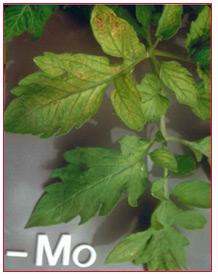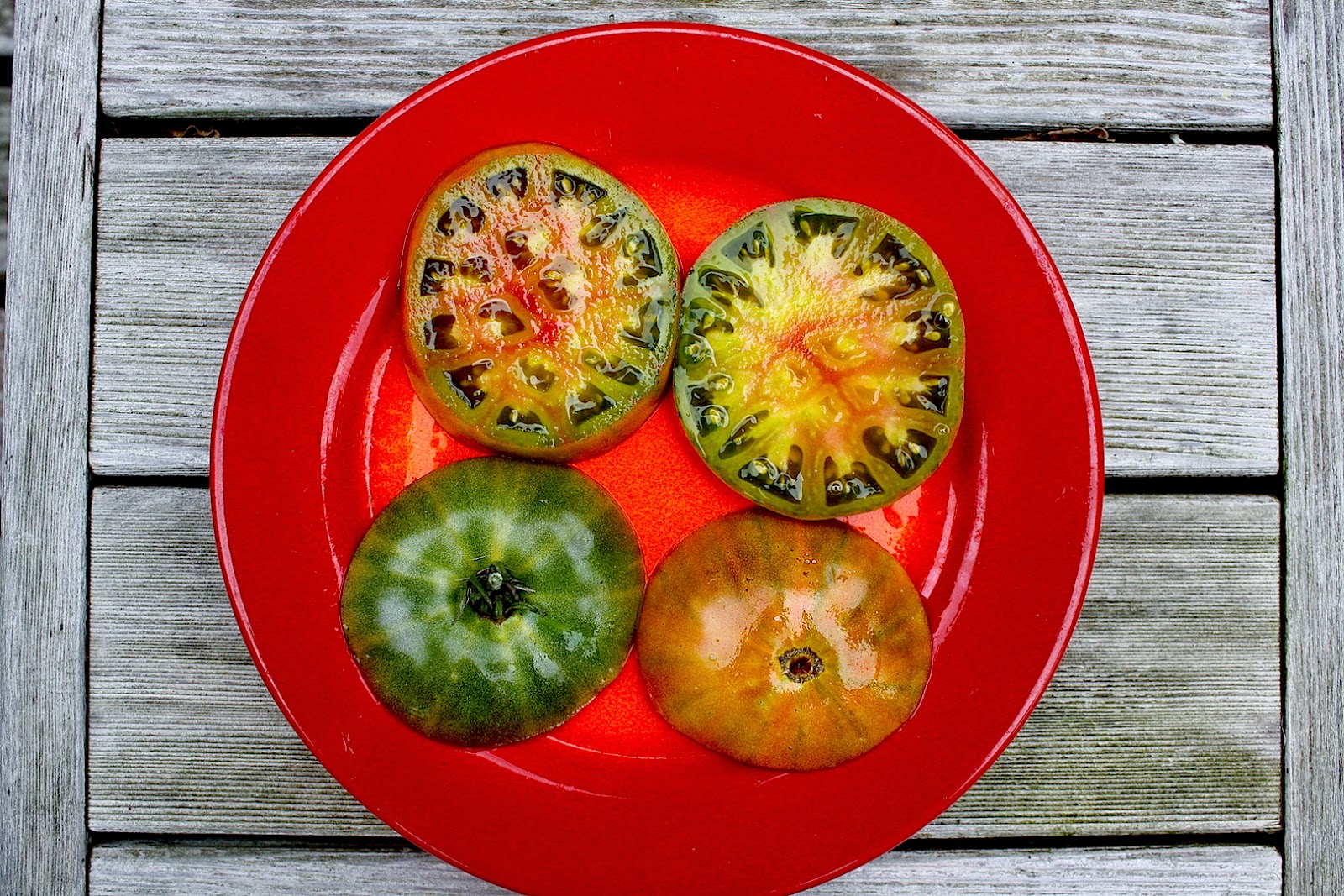Tomato fruitworms (Helicoverpa zea), also called corn earworms and cotton bollworms, are insects that attack tomatoes and other plants. The fruitworm (in its larva form) attacks a tomato by tunnelling. It consumes the tomato’s interior and leaves a cavity filled with fluid and droppings. The tomato quickly decays and rots. Once tomatoes have been attacked by fruitworms, the fruit is no longer usable. Pick and discard them. The best way to deal with tomato fruitworms is to go on the offencive. Watch plants closely to keep an eye out for eggs and then larvae (worms).
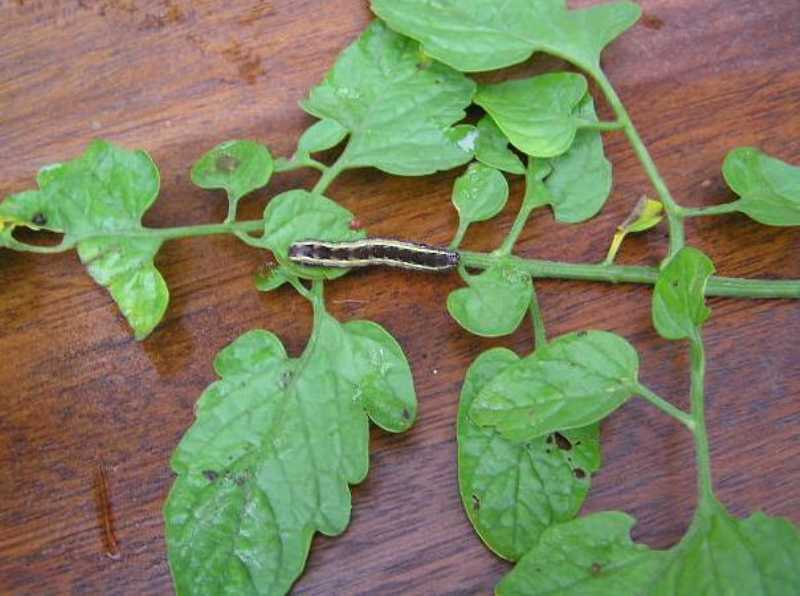
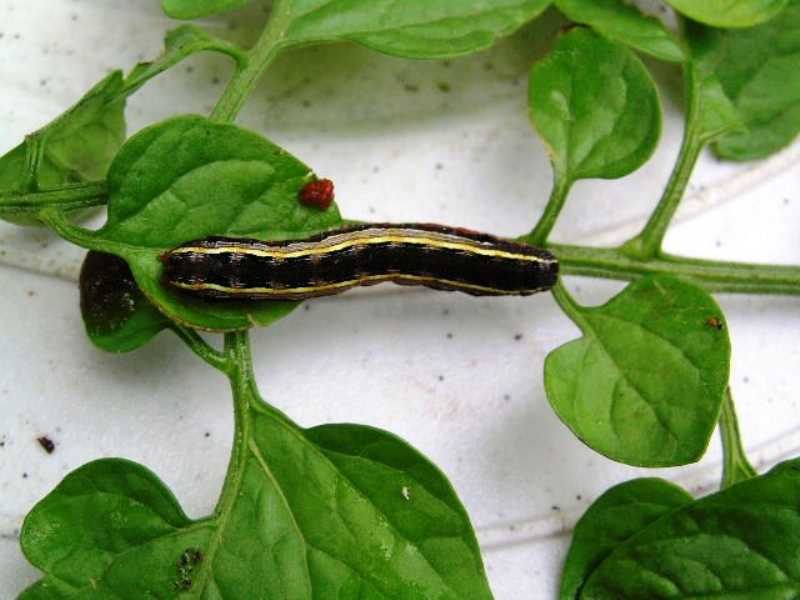
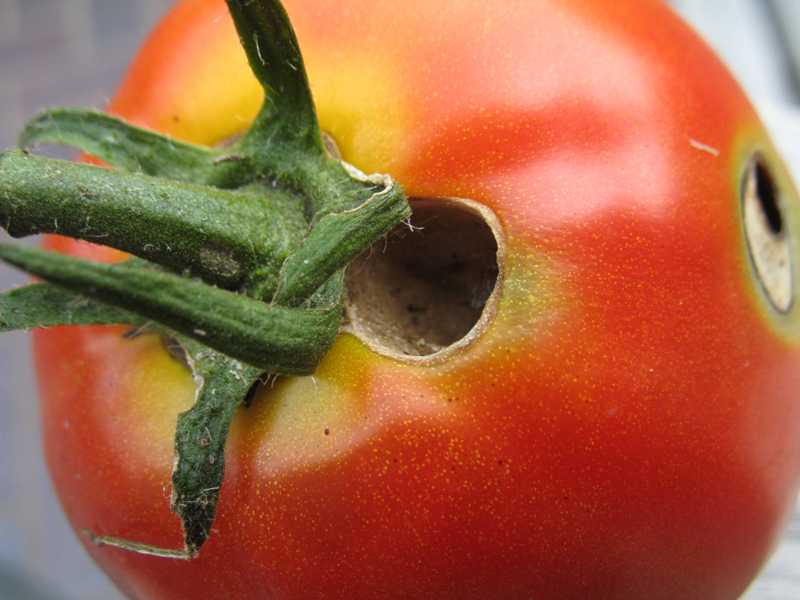
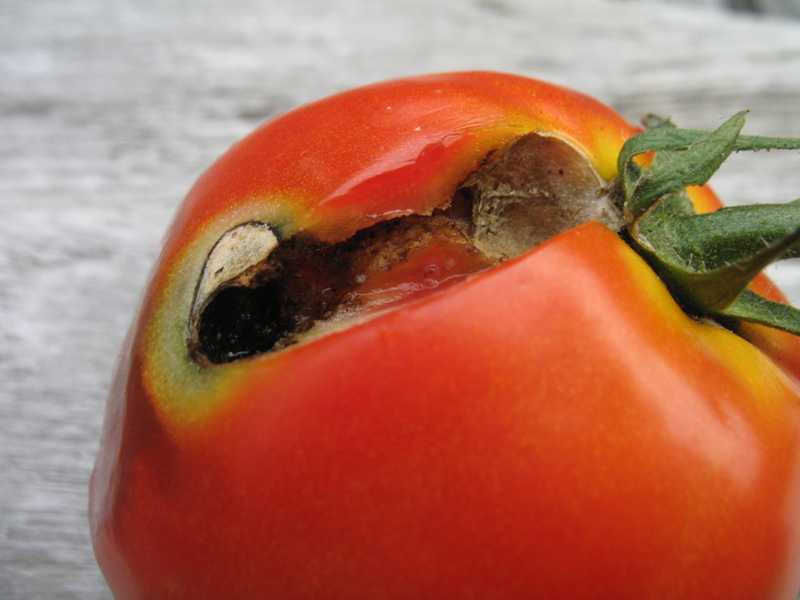
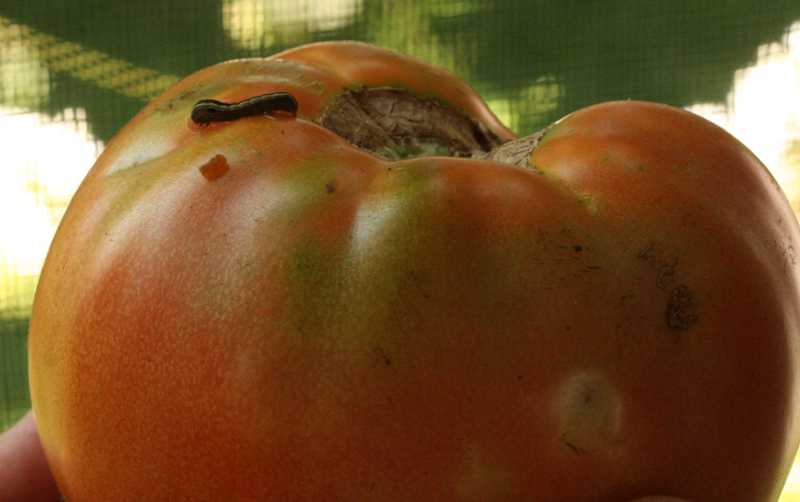

There are at least 15 other cultivated tomato fruitworm hosts in addition to the tomato, including corn, cotton, eggplant, okra, peppers, soybeans, and tobacco.
Shape: caterpillar (in larvae stage)
Colour: cream, yellow, green, reddish, or brown
Markings: pale stripes and/or black spots; hairy
Size: about 1 ½ - 2 inches long
Tomato fruitworm adults are medium-sized moths with a wingspan of about 1 to 1.3 inch (25–35 mm). They are pale tan to medium brown coloured or sometimes have a slight greenish tinge. The front wings are variously marked and usually have an obscure dark spot in the centre and a lighter band inside a dark band around the tip. The hind wings are drab white and have a dark gray band around their tip. A diffuse light spot is in the centre of the dark band.
The eggs of this pest are each about ½ the diameter of a pinhead. They are spherical with a flattened base and white or cream in color, developing a reddish-brown band just prior to the young hatching. Depending on the temperature, the young hatch in 2-10 days.
The larvae measure 11/2-2 inches when fully grown and may be green, brown, pink, yellow, or even black. They have tan heads and alternating light and dark stripes run lengthwise on the bodies. The skin is coarse and has small, thorn-like projections called tubercles. The larval stage lasts 14-21 days.
When the larvae are finished feeding the worms drop to the ground and enter the soil near the base of the plant where they transform into shiny brown pupae. During summer adults emerge in 10-14 days and start the cycle over. In the fall, south of Interstate 70 the pupae survive winter 2-6 inches below the soil surface. The moths emerge from overwintering pupae during late April and May.
Adult moths are usually light yellow-olive in color with a single dark spot near the center of each forewing. Each forewing has 3 slanted dark bands. Their hind wings are white.
The cycle repeats itself with the moths laying eggs at dusk on host plants on warm days. The total generation time is 28-35 days.
The moths lay eggs on the foliage of the tomato plants. With corn the moths usually lay eggs on corn tassels and silks but the larvae will migrate down the silk to the ear tips within one hour of hatching where they will feed on the developing kernels protected by the husk. When larval development is complete the larvae chew through the husk and drop to the ground to begin the pupal stage.
When there is fruit present, the tomato fruitworm will complete its larval development inside fruit. Early stage larvae enter fruit at the stem end when it is between 0.75 to 2 inches in diameter. During development, caterpillars may emerge from one fruit and enter another. Their feeding results in a messy, watery, internal cavity filled with cast skins and feces. Damaged fruit will ripen prematurely. Late in the season, small larvae will also enter ripe fruit. Small larvae are difficult to detect and, thus, may be a problem in processing tomatoes for the canner. Tomato fruitworm is less of a problem for fresh market tomatoes because damaged fruit are easily culled at harvest.
Damage is caused only by the larvae. Although larvae can feed and develop on leaf tissue, the preferred feeding sites in most crops are the reproductive sites, such as tomato fruit and corn ears. On corn, the larvae feed on fresh silk before moving down the ears eating kernels and leaving trails of excrement. In tomatoes, evidence of damage is usually a visible black hole at the base of the fruit stem. They will also eat the flower buds and chew holes in the leaves. It is much the same, though less common, on the other types of plants.
Management of tomato fruitworm requires careful monitoring for eggs and small larvae. When control is needed, it is essential to treat before large numbers of larvae enter fruit, where they are protected from sprays. Trichogramma parasites and other natural enemies often destroy significant numbers of eggs, so it is important to check for parasites before making treatment decisions. Except in the desert valleys, early-season processing tomatoes rarely need treatment. Late-season fields may be more seriously affected.
A tomato fruitworm egg parasite, Trichogramma pretiosum, is available from many commercial insectaries. Inundative releases of 100,000 parasites/acre during the period of fruitworm oviposition and when fruit are susceptible to fruitworm feeding can reduce damage to acceptable levels. Monitor releases using the egg sampling technique to determine the success of the release (indicated by black, parasitized eggs) and use the table below to determine if pesticide treatments are needed. Be sure to monitor the releases to make certain that parasitism is occurring.
Look for signs of fruitworm infestations regularly. Adults lay eggs on both sides of leaves, usually close to blossoms. Ridding of eggs can reduce fruitworm populations drastically. Handpick and destroy fruitworm eggs and larvae as you find them.
Prevent fruitworms from boring into fruit by covering fruit with fine netting. Better yet, cover plants with floating row-covers to prevent adults from laying eggs on host plants.
Avoid growing tomato near corn or any other aforementioned crop, unless your intention is to use them as a trap crop. If one plant gets infested, you could have your garden teeming with fruitworms!
Encourage natural predators of the tomato fruitworm. Big-eyed bugs, minute pirate bugs, lacewing and damsel bugs feed on tomato fruitworms. Attract them by planting goldenrod, daisies, alfalfa and stinging nettle.Trichogramma wasps and Hyposoter exiguae wasps parasitize the eggs and larvae respectively. Planting dill, parsley and asters attracts the parasiticTrichogramma wasps. These wasps are available commercially and can be ordered.
Bacillus thuringiensis (Bt), a microbial biological control, is effective against tomato fruitworms among several other pests. Use Bt at the first sign of fruitworm eggs. Apply as directed by the product label. Bt works by paralyzing the digestive system and infected fruitworms stop feeding within hours.
Neem oil and biodegradable insecticidal soaps have been found to deter fruitworm infestations. Spinosad, a natural, broad-spectrum biological insecticide made from soil microbes works on tomato fruitworms too.
Cultural control: Remove and destroy infected plants. Roto-till the soil at the beginning and end of the season to expose and destroy overwintering fruitworm pupae. Rotate crops by planting tomatoes in a different area of your garden each year. Companion planting with garlic has been said to repel many pests.
Dusting plants with diatomaceous earth or Rotenone can help deter fruitworms from moving about the plant.
Prevention is the most effective way to control worms (see above). Once larvae enter fruit, they cannot be treated directly, since they’re protected by the tomato’s exterior. But before that happens, you can take these precautions.






Description of tomato fruitworm
A major agricultural pest, the tomato fruitworm can feed on many different plants. Hence, the species has been given many different common names including cotton bollworm and corn earworm. It has also been known to consume tobacco, legumes, grain sorghum, and other vegetables and fruits.
Adult moths have yellowish tanned bodies, a tan-coloured head and bright green eyes. A solitary dark dot in the middle of each forewing coupled with several dark markings help distinguish them. The hindwings are pale in colour and is enveloped by a dark brown border.What does the tomato fruitworm look like?
Colour: cream, yellow, green, reddish, or brown
Markings: pale stripes and/or black spots; hairy
Size: about 1 ½ - 2 inches long
Life cycle
The eggs of this pest are each about ½ the diameter of a pinhead. They are spherical with a flattened base and white or cream in color, developing a reddish-brown band just prior to the young hatching. Depending on the temperature, the young hatch in 2-10 days.
The larvae measure 11/2-2 inches when fully grown and may be green, brown, pink, yellow, or even black. They have tan heads and alternating light and dark stripes run lengthwise on the bodies. The skin is coarse and has small, thorn-like projections called tubercles. The larval stage lasts 14-21 days.
When the larvae are finished feeding the worms drop to the ground and enter the soil near the base of the plant where they transform into shiny brown pupae. During summer adults emerge in 10-14 days and start the cycle over. In the fall, south of Interstate 70 the pupae survive winter 2-6 inches below the soil surface. The moths emerge from overwintering pupae during late April and May.
Adult moths are usually light yellow-olive in color with a single dark spot near the center of each forewing. Each forewing has 3 slanted dark bands. Their hind wings are white.
The cycle repeats itself with the moths laying eggs at dusk on host plants on warm days. The total generation time is 28-35 days.
The moths lay eggs on the foliage of the tomato plants. With corn the moths usually lay eggs on corn tassels and silks but the larvae will migrate down the silk to the ear tips within one hour of hatching where they will feed on the developing kernels protected by the husk. When larval development is complete the larvae chew through the husk and drop to the ground to begin the pupal stage.
Damage to the crop
Other damage includes:
- Tomato fruitworms feed on leaves, stems, and fruit.
- Worms (larvae) enter fruit, usually at the stem end, and can work their way through the entire tomato. The entry hole can be up to the size of a pea.
- Worms prefer green fruit.
- Worms leave an interior hollow space filled with water, frass, decay, and rot. Fruit is inedible after a fruitworm infestation.
Prevention of tomato fruitworm
- Avoid planting corn near tomatoes because corn is one of the most significant fruitworm hosts.
- Monitor plants for eggs and hand pick leaves where eggs are laid. Adults lay eggs on both sides of tomato leaves, beginning closest to blossoms. Eliminating eggs reduces population dramatically.
- Prevent larvae from entering fruit by covering plants with fine netting.
- Encourage natural predators. Plant dill, parsley, and asters to attract parasitic Trichogramma wasps. Parasitic wasps can also be purchased and released into the garden. Big-eyed bugs, minute pirate bugs, lacewing, and damsel bugs also feed on tomato fruitworms. Plant goldenrod, daisies, alfalfa and stinging nettle to attract them.
- Remove and destroy affected plants at the end of the season.
- Till soil after harvest, in late winter, and in early spring to destroy pupae.
Management and control
Biological control
Naturally occurring beneficial insects are very important in the biological control of tomato fruitworm, especially in the Delta areas. These include Trichogramma spp. egg parasites, the larval parasite Hyposoter exiguae, and predators such as bigeyed bug and minute pirate bug. Conserve these parasites whenever possible and monitor their presence.A tomato fruitworm egg parasite, Trichogramma pretiosum, is available from many commercial insectaries. Inundative releases of 100,000 parasites/acre during the period of fruitworm oviposition and when fruit are susceptible to fruitworm feeding can reduce damage to acceptable levels. Monitor releases using the egg sampling technique to determine the success of the release (indicated by black, parasitized eggs) and use the table below to determine if pesticide treatments are needed. Be sure to monitor the releases to make certain that parasitism is occurring.
Controlling tomato fruitworms origanically
You can avoid the use of harsh chemicals and employ organic methods to rid your tomato crop of fruitworms. Instructions:- Release fruitworm predators in your garden. Predators include minute pirate bugs, bigeyed bugs, the parasite trichogramma and Hyposoter exiguae wasps.
- Till the soil around the tomato plants in the fall. This exposes fruitworms to predators. Exposure to cold weather also kills fruitworm pupae.
- Look for signs of fruitworm infestation regularly. Fruitworm moths lay eggs on tomato plant leaves. The eggs appear white when first laid, then turn brown before the larvae hatch.
- Handpick and destroy fruitworm eggs and larvae as you find them.
- Spray tomato plants with Bacillus thuringiensis at the first sign of eggs or infestation. To prepare the spray, combine 1 to 2 tablespoons of the bacteria with 1 gallon of water. Apply the spray to the tops and bottoms of leaves.
Look for signs of fruitworm infestations regularly. Adults lay eggs on both sides of leaves, usually close to blossoms. Ridding of eggs can reduce fruitworm populations drastically. Handpick and destroy fruitworm eggs and larvae as you find them.
Prevent fruitworms from boring into fruit by covering fruit with fine netting. Better yet, cover plants with floating row-covers to prevent adults from laying eggs on host plants.
Avoid growing tomato near corn or any other aforementioned crop, unless your intention is to use them as a trap crop. If one plant gets infested, you could have your garden teeming with fruitworms!
Encourage natural predators of the tomato fruitworm. Big-eyed bugs, minute pirate bugs, lacewing and damsel bugs feed on tomato fruitworms. Attract them by planting goldenrod, daisies, alfalfa and stinging nettle.Trichogramma wasps and Hyposoter exiguae wasps parasitize the eggs and larvae respectively. Planting dill, parsley and asters attracts the parasiticTrichogramma wasps. These wasps are available commercially and can be ordered.
Bacillus thuringiensis (Bt), a microbial biological control, is effective against tomato fruitworms among several other pests. Use Bt at the first sign of fruitworm eggs. Apply as directed by the product label. Bt works by paralyzing the digestive system and infected fruitworms stop feeding within hours.
Neem oil and biodegradable insecticidal soaps have been found to deter fruitworm infestations. Spinosad, a natural, broad-spectrum biological insecticide made from soil microbes works on tomato fruitworms too.
Cultural control: Remove and destroy infected plants. Roto-till the soil at the beginning and end of the season to expose and destroy overwintering fruitworm pupae. Rotate crops by planting tomatoes in a different area of your garden each year. Companion planting with garlic has been said to repel many pests.
Dusting plants with diatomaceous earth or Rotenone can help deter fruitworms from moving about the plant.
Monitoring and treatment decisions
Damaging populations of tomato fruitworm rarely occur before August. Monitor adult activity in July using a Heliothis trap baited with a pheromone lure to determine when to sample for eggs, which are laid during the flight periods. When moths are being caught in the traps, begin sampling leaves for eggs. If eggs are detected in samples taken during July, start accumulating degree-days using a lower threshold of 55°F and an upper threshold of 92°F to predict egg laying of the generation in August that attacks the fruit. It takes an average of 968 degree-days for tomato fruitworm to complete a generation.- Apply Bt: Bacillus thuringiensis (Bt), a microbial biological control, is considered to be very effective on fruitworms. Bt doesn't harm a majority of beneficial insects. It’s available in liquid, powder, and granules. Follow manufacturer’s directions for application. Treat plants with Bt in the afternoon or evening, since it breaks down in UV light. Apply Bt at the first sign of worm eggs. Once the pests hatch and ingest the chemical, they are paralyzed, unable to eat, and die.
- Apply oils. Use neem oil or insecticidal soap once a week and after rain.
- Apply other controls. Treat plants with Spinosad, a natural, broad-spectrum insecticide made from soil microbes. Or treat plants with the insecticide Sevin every 5-7 days when fruit begins to set (worms are untouchable once they get inside tomatoes).

